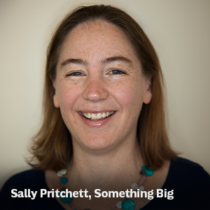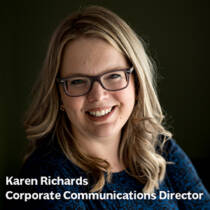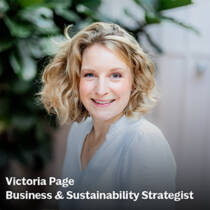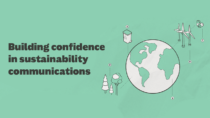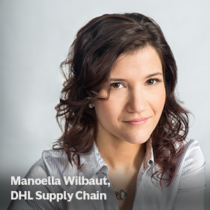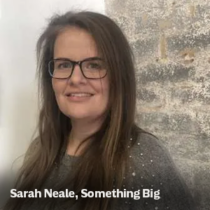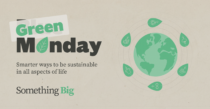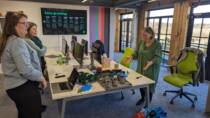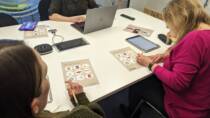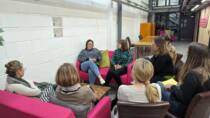Green Monday 2026: What’s On
By Sally Pritchett
CEO
Discover this year’s Green Monday sessions and resources for thoughtful sustainability conversations.
The third Monday in January is widely known as Blue Monday, often labelled the most depressing day of the year. Three years ago, we decided to flip that narrative. Green Monday is our antidote – a day we dedicate to sustainability, connection and practical action. Each year, we bring people together for conversations and experiences that spark new ideas and drive progress.
For 2026, we are hosting two sessions focused on the communication challenges that shape sustainability work, plus a new resource to help you run your own Green Monday NetWalk.
NetWalk
Time: 8am-10am GMT, Mon 19 Jan 2026
Tannery Studios, Tannery Lane Send, Woking Surrey, GU23 7EF
Start Green Monday with a morning NetWalk through the Surrey countryside. It is a great opportunity to meet others who care about making a positive impact on our planet and to share ideas in an informal setting. Led by our CEO, Sally Pritchett, and Ali Fisher from Plans With Purpose, we will meet at the Something Big office for a warm drink before heading out together.
Rain or shine, boots or wellies are a must!
Closing the Gap – Turning Sustainability Strategy into Everyday Employee Action
Time: 12pm-1pm GMT, Mon 19 Jan 2026
Online, Teams
Sustainability strategies often look clear on paper, yet feel anything but clear in the day to day. Teams are already overloaded with information, priorities and internal messaging which makes it harder for people to know what to do, when to do it and how it fits into their role. So even when employees care, there is still a gap between intention and action.
In this one hour session, we will explore what gets lost in the noise and what it takes to make sustainability feel practical and relatable for busy teams.
New for 2026: Run Your Own Green Monday NetWalk
Free downloadable guide
If you’d like to bring Green Monday into your organisation, team or community, we’ve created a simple one page guide to help you run your own NetWalk.
It includes:
- Tips for planning
- Conversation starters
- Ready to use social media assets to help you celebrate your walk
Download the guide now and get everything you need to run a Green Monday NetWalk wherever you are.
Powered by Work Wonders

Sustainability and Environmental Awareness Calendar 2026
By Sally Pritchett
CEO
Free downloadable calendar of key sustainability and environmental awareness days.
Keep sustainability on the agenda all year round
Our free Sustainability and Environmental Awareness Calendar brings together key global dates and events to help you plan meaningful activity throughout 2026.
With sustainability now central to how people choose where to work and what brands to trust, keeping the conversation alive matters. 68% of jobseekers say an organisation’s environmental policies influence where they apply, and 65% say it affects whether they stay. This calendar helps you connect your sustainability goals with communication moments that inspire action and pride.
What’s inside
-
Global and UK sustainability and environmental awareness days
-
Dates covering climate action, conservation, recycling, and sustainable living
-
Practical ideas to turn awareness days into engaging campaigns and conversations
If you find this calendar helpful, you might also like: Diversity and Inclusion Calendar 2026, Employee Wellbeing Calendar 2026, Future of Work, Productivity & Digital Skills Calendar 2026, and Health and Safety Awareness Calendar 2026.
If you’re looking to strengthen your sustainability communications or bring your ESG story to life for employees, get in touch to see how we can help.
Download your free Sustainability and Environmental Awareness Calendar 2026
Guide: Building confidence in sustainability communications
By Sally Pritchett
CEO
Your shortcut to confident, compelling and trustworthy sustainability comms.
Sustainability comms is one of the hardest things to get right.
Say too little, and people won’t know about all the great work you’re doing. Say too much, and you could risk being accused of greenwashing. The stakes are high, but the opportunity is huge – when you get it right, you build trust, inspire action and create real change.
This guide is here to help you do exactly that.
Whether you’re a communications professional tasked with telling the sustainability story – or a sustainability lead trying to get people to listen – this practical manual is designed to help you communicate with clarity, honesty and impact.
What’s inside:
- Why sustainability comms is uniquely challenging – and how to overcome the common traps
- How to communicate honestly without greenwashing – or greenhushing
- Tips for choosing the right words, tone and visuals
- Insights on how different generations engage with the topic of sustainability
- Real-world examples, do’s and don’ts and easy wins you can start using right away
- Cut through the noise. Say what matters. And say it in a way people trust.
Download the manual and start building confidence in your sustainability comms.
Download here
We’ve created two accessible versions of the manual – light and dark mode – both optimised for screen readers. Choose the one that works best for you. Need help? Just drop us a line at hello@somethingbig.co.uk.
PDF version
A PDF that can be read by a screen reader
Dark mode PDF
A PDF in dark mode, that can be read by a screen reader
The key trends shaping happy and high-performing teams
By Sally Pritchett
CEO
What does it take to build a workplace where happiness fuels high performance?
What does it take to build a workplace where happiness fuels high performance?
To celebrate B Corp Month, our CEO, Sally Pritchett, joined a panel of B Corp leaders and industry experts at Uncommon Holborn to explore just that. In conversation with Bleddyn Harris, Head of People and Culture at B Lab, the discussion revealed key trends shaping the future of work and what businesses can do to create thriving, engaged teams.
Rethinking workplace culture
Too many businesses are still stuck in an outdated industrial mindset – viewing employees as cogs in a machine that need to be optimised and replaced when they break. But workplaces are ever-evolving living ecosystems, filled with diverse identities, ideas and experiences.
To create a culture where employees thrive, businesses must:
- Listen deeply – go beyond surveys to understand the real undercurrents shaping employee experience.
- Make change an engaging process – design change communications to be creative, inspiring and participatory.
- Enable flow states – consider how workspace design, communication styles and celebrations contribute to culture.
- Embrace conscious leadership – leaders should create a positive and collaborative environment where everyone can thrive.
Tackling loneliness
Loneliness has become a big and unfortunate trending topic, but it is important to know that it is not caused by remote work – it’s caused by fractured cultures. Return to office mandates are part of the loneliness problem; what could be lonelier than feeling disconnected from your colleagues while sitting in a buzzy office? Communication plays a vital role in bridging that gap.
Valuing feedback
Surveys, suggestion boxes and employee groups may seem like standard tools – but they only work when they are inclusive and transparent.
Key principles of effective feedback include:
- Providing multiple ways to contribute – recognising potential language and other barriers, offering different ways to feedback.
- Appointing spokespeople – ensuring non-native speakers and those not comfortable with speaking up can have a voice.
- Creating a genuine feedback loop – sharing all survey results, addressing difficult feedback and being honest when changes aren’t possible.
- Targeting disengagement – where you are seeing signs of disengagement, for example low survey response rates, investigate the cause. Would tailored training or perhaps surveys in multiple languages or formats help?
Communicating through change
During times of change, clarity and consistency are everything. Strong leadership voices, regular updates and a visible presence – with an example given of a CEO spending time working from reception – can create a sense of stability.
Humans are natural storytellers. If leaders don’t shape the narrative, employees will create their own – and that’s where misinformation can spread. Tapping into the stories that drive purpose fuels both innovation and productivity.
Creating human-centric work environments
A desk and chair are no longer enough. The spaces we work in play a crucial role in collaboration, focus and connection. The venue itself, Uncommon’s Holborn location, is a perfect example of how human-centric design, greenery and calming aesthetics can enhance workplace wellbeing.
Modern workplaces need to provide flexibility, offering spaces that support both deep work and collaboration. Thoughtful design can create an environment that facilitates productivity and meaningful interactions.
Supporting volunteering programmes
Businesses offering paid volunteering days is on the rise, but offering the benefit doesn’t automatically result in take-up – businesses need to actively encourage participation.
Volunteering isn’t just good for the individual – it strengthens engagement, productivity and workplace culture. It tackles loneliness, builds community and enhances wellbeing. The key is making it easy for employees to get involved.
Want to see how we helped a client inspire over 120,000 employees to volunteer? Find out more here.
Overcoming communication overload
Communication tools like video calls and instant messaging were meant to streamline work. Instead, they’ve created a culture of constant communication – where employees are drowning in notifications, meetings and distractions. The workplace is now like a crowded room where everyone is talking at once. It’s affecting productivity, wellbeing and relationships. To fix this, businesses must:
- Set clear communication guidelines – establish expectations for response times and message urgency.
- Encourage mindful communication – leaders should model concise, purposeful messaging.
- Reduce unnecessary noise – assess which platforms are essential and eliminate redundant ones.
Communication: the key to workplace happiness and performance
At the heart of all these trends lies communication. Getting it right means understanding what, when and how to communicate – ensuring efficiency without overload. Talk to your teams, listen to what they need and create a workplace where communication fuels success rather than hinders it.
A happy, high-performing team isn’t built overnight. But with purposeful communication, inclusive culture and thoughtful leadership, businesses can create environments where people truly thrive.
At Something Big, we help businesses communicate with clarity, creativity and inclusivity – making workplaces fairer, healthier and happier. From shaping strategy and change programmes to fostering wellbeing and inclusion, we work with some of the world’s best workplaces to engage leaders, managers and frontline teams through impactful communication.
Ready to build a thriving workplace? Let’s talk.
Green Monday 2025: Catch up on the sessions
By Sally Pritchett
CEO
Planning your next Green Monday? Find the latest line up and resources here.
Green Monday was a big success!
We said goodbye to Blue Monday – the so-called “most depressing day of the year” – and had a day dedicated to positivity and sustainability.
Together, we NetWalked, tackled the biggest challenges to business change, discussed how to bring stakeholders along the sustainability journey, and explored the power of impactful reporting. And a big thank you to our speakers for their thought-provoking contributions, and to everyone who walked, listened, shared, and connected.
Catch up on Green Monday
Breaking down the 3 big obstacles in business change
Discover how communications can help overcome the common challenges to change and sustain momentum through the ups and downs.
Bringing your stakeholders on the sustainability journey
Learn how to engage employees, customers, investors, and communities with authentic ESG communications.
Creating clear and credible corporate reports
Explore how impactful reporting can build trust, inspire action, and showcase meaningful progress.
Your sustainability story deserves to be told
See how we can help you create beautifully designed reports that inform and inspire your stakeholders while driving meaningful progress.
Green Monday: a day of sustainability-focused events
By Sally Pritchett
CEO
Planning your next Green Monday? Find the latest line up and resources here.
Green Monday – the 20 January – is our antidote to the so-called ‘most depressing day of the year’. Blue Monday might focus on the post-holidays slump but we’re flipping the narrative – transforming it into a series of inspiring events dedicated to sustainability.
With workshops, panel discussions, and networking opportunities, Green Monday is your chance to connect with like-minded professionals, share ideas, and gain practical tools to drive meaningful change.
Explore the full schedule below and join us in making a positive impact – for your business, your communities, and our planet.
NetWalk
Time: 8am-10am GMT, Mon 20 Jan 2025
Tannery Studios, Tannery Lane Send, Woking Surrey, GU23 7EF
Kick off Green Monday with a refreshing NetWalking session in the scenic Surrey countryside, connecting with sustainability professionals to share insights on 2024 progress, challenges, and ambitions for 2025.
Led by our CEO, Sally Pritchett, and Ali Fisher from Plans With Purpose, we’ll explore how communication drives sustainable progress before returning to the Something Big office for a warm drink and continued conversation. Rain or shine, boots or wellies are a must!
Breaking down the 3 big obstacles in business change – and how communications can help
Time: 11am-12pm GMT, Mon 20 Jan 2025
Online, Teams
What makes change so challenging, and how can communications help smooth the path? In this interactive session, we’ll uncover three common obstacles businesses face when driving change and explore how communications can address them. Led by our Nicky Leach from The Spiral Hub and our CEO, Sally Pritchett you’ll gain strategic insights, practical tools, and real-time exercises to sustain momentum and keep your team engaged through the ups and downs of meaningful change.
Sustainability Speed Dating
Time: 1pm-2pm GMT, Mon 20 Jan 2025
Online
Being the driving force for change can feel isolating. As a sustainability manager, you’re navigating resistance, balancing pressures, and pushing for innovation – often solo.
This Green Monday, connect with others who share your passion. Join us for an energising virtual networking session to exchange experiences, share strategies, and build valuable connections.
A big thank you to our hosts Standing on Giants.
Bringing your community on the sustainability journey
Time: 2.30pm-4pm GMT, Mon 20 Jan 2025
Online, Teams
How can you authentically connect with employees, customers, investors, and communities on your sustainability journey? What does it take to communicate ESG efforts with clarity and build trust among stakeholders?
For this panel discussion we will be joined by:
- Andrew Richmond, UK Communications Manager, Cemex
- Manoella Wilbaut, Board Member and President, Oxfam
- Jess Fielder, Global Head of Marketing, CDP
Together, they’ll share insights on crafting confident, impactful messages that resonate, inspire trust, and drive meaningful action. Perfect for sustainability managers, communications professionals, and business leaders looking to align and engage their communities effectively.
Creating clear and credible corporate reports
Time: 4.30pm-5pm GMT, Mon 20 Jan 2025
Online, Teams
How can businesses share their progress in a way that’s transparent, accessible, and impactful?
In this 30-minute session, we’ll explore how great corporate reports build trust and drive progress. You’ll gain practical tips to structure clear, engaging reports, avoid pitfalls like greenwashing, and use inclusive design to reach your audience effectively.
Ideal for sustainability managers, corporate communicators, and business leaders looking to inspire trust and action.
Sustainability and Environmental Awareness Calendar 2025
By Sally Pritchett
CEO
Download your free Sustainability and Environmental Awareness Days Calendar for 2025.
Our free Sustainability and Environmental Awareness Calendar can help you plan your activities for 2025, featuring key awareness dates and events that drive positive change.
Keeping sustainability high on your communications agenda is essential for talent acquisition and employee retention. ESG and planetary responsibility are crucial topics for your employees, with 68.6% of those choosing an employer stating that environmental policies and practices are important, and 65.5% indicating these policies influence their decision to stay with an employer.
Why You Need a Sustainability and Environmental Awareness Calendar in 2025
- Focus Your Sustainability Communications: Utilise awareness and celebration days throughout the year to guide your sustainability efforts.
- Raise the Profile of Your Green Activities: Highlight opportunities to engage in meaningful conversations about sustainability.
- Make the Most of Key Awareness Dates: Our top tips can help you to make the most of these events and engage your employees with the important work of protecting our planet.
If you find this calendar useful, then check out our Diversity and Inclusion Calendar and Employee Health and Wellbeing Calendar.
At Something Big we’re passionate about helping businesses raise the profile of their sustainability activity. If you’re looking to make a difference to the planet and need some help rolling out your sustainability and environmental awareness programmes, talk to us. We’d love to help.
Need help communicating your sustainability message? Download our free guide for clear, practical tips to build confidence in your comms. Get the guide →
Download our Sustainability and Environmental Awareness calendar
Q4 2024 Awareness Days Calendar
By Sally Pritchett
CEO
Download your free Awareness Days Calendar for Q4 2024.
As we begin to plan for the end of the year, it’s important to keep employee wellbeing, sustainability, and diversity and inclusion top of mind. Our downloadable Q4 2024 Awareness Days Calendar highlights key dates in October, November, and December to help you:
Wrap up the year on a positive note:
- Organise end-of-year employee wellness programs
- Celebrate your sustainability achievements
- Reflect on diversity and inclusion progress
- Engage employees in thoughtful discussions
- Acknowledge important events for colleagues and customers
Don’t miss the opportunity to end 2024 strong and lay the groundwork for an even better 2025.
If you need support maximizing these awareness days, get in touch to see how we can help.
Download our Key Awareness Days Calendar for Q4 2024
5 ways to engage employees with your sustainability communications
By Sally Pritchett
CEO
Improve employee engagement with your sustainability communications with these simple, but effective, strategies.
Living a more sustainable life requires us to change our behaviour, make ongoing commitments and sometimes make sacrifices – but despite all this, it’s not always easy to see the rewards of our hard work.
When we recycle or use the circular economy, the planet and the headlines don’t change. We’re still hearing that climate change is going in the wrong direction, despite the collective action we are all taking. And that’s why we’re starting to see more people experiencing sustainability fatigue.
What is sustainability fatigue?
Simply put, sustainability fatigue is a phrase that describes how people feel when, despite making choices that are better for the planet, they constantly see negative environmental news and start to think the changes they are making aren’t making a difference. So they start to make less effort or even give up altogether.
The challenges of sustainability fatigue
Sustained behaviour change is not easy
Humans are psychologically wired to value the things we already have more than those we don’t have. When it comes to encouraging people to embrace more sustainable lifestyles, asking them to let go of something they’re emotionally connected to is a challenge.
Making changes might not be cheap
Humans are facing a dilemma; they want to make changes that positively impact the environment but can’t always afford to do so. With 21% of people saying it is too expensive to make changes, this could be stopping people from living their lives as sustainably as they would like to.
The extent of change required is overwhelming
As people ocellate between taking proactive action and feeling overwhelmed by the lack of progress, it’s no surprise that climate anxiety is rising – more than 80% of British adults say they have some level of concern about climate change. These feelings of concern are as real as climate change itself, so it’s no wonder people aren’t sure where to start, what to believe or where to focus their action.
Whilst people may be facing these challenges in their personal lives, sustainability has scaled the corporate agenda. And many businesses are doing more than ever to have a positive impact on the environment. But have you considered how your communications could provide support to your employees’ personal sustainability journeys?
Strategies for engaging employees with your sustainability communications
-
Change the tone
Remember, people know what’s going on, and many are already anxious. This is especially true for the younger generations who are starting to enter the workforce, with 31% of 16-24 year olds saying they are very worried about climate change. It’s time to try ditching the doom and gloom and lightening up communications, balancing important information with a little fun to raise awareness.
Strategy: Try interviewing your subject matter experts with quick-fire questions or turning educational communications into a quiz-style interview. Giving a voice to real people around your business can help make changes feel achievable and realistic – people need to hear the authentic truth about how colleagues who are similar to them have managed to change their behaviour.
-
Get (and keep) talking
It’s more important than ever to keep the conversation going. Communication can reduce anxiety by reassuring employees that your organisation is taking sustainability seriously. Keep employees consistently in the loop with the progress you’re making and bring to life all the achievements (and failures) big and small.
Strategy: Consider whether you could help your Head of Sustainability or key subject matter experts to publish a diary, vlog or blog to continually share their updates.
-
Get competitive
As humans, we all fall for a bit of gamification, in and out of the workplace. With 82% of employees say that game elements help provide a greater sense of meaning and purpose in their workplace, gamification can be about more than just a bit of fun.
Strategy: How about challenging different offices, locations or departments to see who can collect the most recycling, reduce their digital storage by the most or carry out the most volunteering?
-
Empower your employees
Enabling action is a great way to reduce anxiety and get change happening. How you empower your employees will depend on the kind of organisation you are, but remember your front-line workers might have the answers to make big changes.
Strategy: Try brainstorming ways your employees can practice more sustainable activities at work, from switching off lights to having a digital declutter, give them tangible things they can take action on and possibly implement at home too.
-
Start a movement
Building a growing community of employee advocates and champions is a great way to build up momentum. With 66% of employees rating employee resource groups as an effective way to foster a sense of community, this can provide an opportunity for employees to bond and engage, as well as taking the benefit of taking positive action.
Strategy: Sustainability employee resource groups or Green Teams are a great source of new ideas, from how to reduce waste to setting up recycling hubs, and internal employee swap shops to creating an onsite vegetable roof garden.
If you’re in search of ESG communication experts to engage employees with sustainability communications, then look no further – you’ve found us! We would be delighted to hear from you to explore the possibility of partnering together.
Creating a culture of sustainability
By Sally Pritchett
CEO
How can businesses promote environmental action and cultivate a culture of sustainability among employees?
Businesses that embrace sustainability can build trust with customers and stakeholders, improve their reputation, and foster a positive work environment. However, despite the growing importance of sustainability, many businesses are struggling to meet their goals. One key reason for this is that they often fail to properly engage their employees and take them on the sustainability journey.
As organizations adapt to combat climate change, the focus must shift inward – towards internal culture and how employees embrace the necessary changes to minimize their impact on the planet. Fostering a sustainability culture isn’t just advantageous; it’s a powerful opportunity for positive change, both within the workplace and beyond.
While many businesses acknowledge the need for environmental action, creating real passion among employees requires something more. We need to create a culture of sustainability.
Creating Green Monday – a collective sustainability learning opportunity
At Something Big, we’ve been on a long sustainability journey. Bolstered by our B Corp status, we’ve measured carbon emissions, offset through carbon avoidance projects, embraced sustainable suppliers and production, increased our carbon literacy through tailored employee training, celebrated the circular economy and initiated easy recycling for our team. And we have of course been taking our customers on this journey too.
To kick off 2024 on a green note, we transformed Blue Monday into Green Monday – a day dedicated to embracing positive environmental change. We ran a series of engaging and interactive sessions covering a variety of sustainability-related topics, from making our personal finance greener to understanding how to recycle tricky items, leverage the circular economy and reducing our food waste, even getting going with planting our office garden. For lunch, we rescued unsold food through Too Good To Go to share, introducing the idea of buying surplus food to many of the team. We finished the session with our ‘Pledge Tree’, which is now full of commitments inspired by our newfound knowledge.
But the impact goes far beyond Green Monday itself. Shared experiences not only deepen our understanding of the issues but also strengthen our team culture. Coming together sparks meaningful conversations and roots new ideas within the fabric of our team. It creates a foundation of shared understanding and a launchpad for continuous conversation. Internally run events and impactful communications have a lifespan that impacts culture in the longer term.
But what did Green Monday teach us about fostering a sustainability culture?
Creating a sustainability culture
Our journey with Green Monday unearthed valuable insights into fostering a workplace culture that prioritises the planet. Here are key takeaways:
- Keep it achievable: For Green Monday we curated a series of engaging sessions covering a variety of different sustainability-related subjects, but crucially we started conversations on topics that are within individual control. We steered clear of topics that require expensive or extreme lifestyle changes. Our goal was inclusion, and showing we can all make a meaningful difference.
- Keep it positive: It can be hard to talk about environmental destruction while keeping it positive, and inevitably falling into sustainability fatigue. We focused on fun, positive and personally beneficial behaviour changes, making the sessions insightful and interactive.
- Keep it safe: While no one can reasonably deny the impact of climate change, our knowledge of how to combat it and our understanding of our personal responsibility may vary. We made sure to keep a safe and respectful environment, creating an opportunity for everyone to feel safe and to learn from each other.
- Keep politics out of the conversation: While how you vote may be one of the most impactful ways of protecting our planet, ultimately to stay in our lane and keep the conversations inclusive, safe and fun for everyone, we were careful to stick to the facts and keep politics out.
- Make it measurable: We asked our team to complete a survey on how far along they are in their sustainability journey on a variety of topics. As we continue these conversations and learnings throughout the year, we will then be able to survey our team again and (hopefully!) show real impact. Our ‘Pledge Tree’ is also full of quantifiable goals, that we can look back on to show our impact.
If you’re seeking ESG communication experts to engage employees with sustainability communications, look no further. Talk to us; let’s make sustainability a focal point in your workplace conversations.



